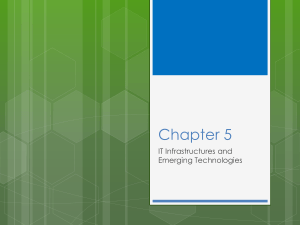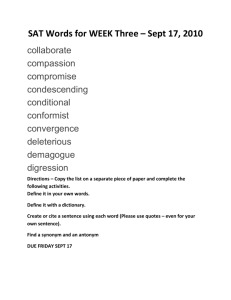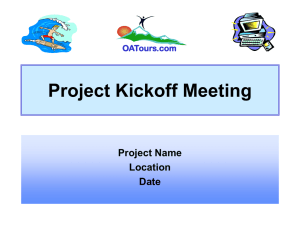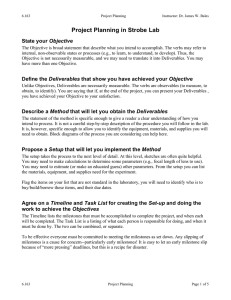MBA 730 session 1 fall 2004
advertisement
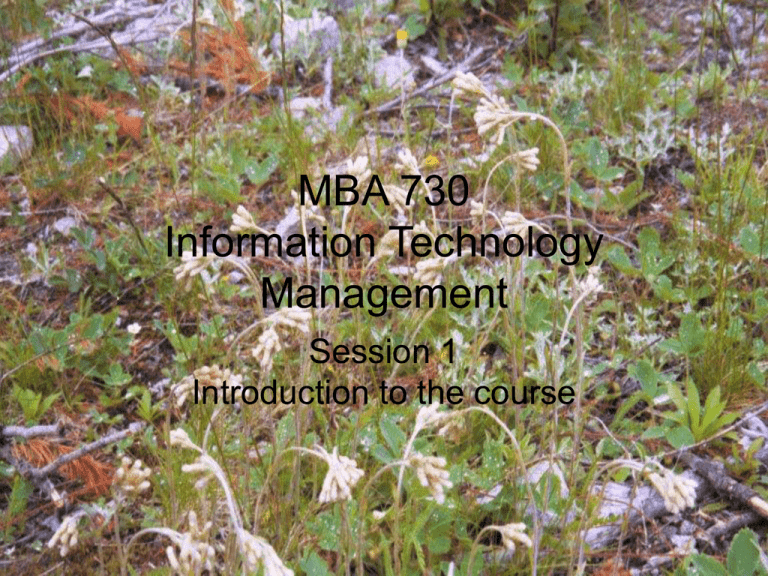
MBA 730 Information Technology Management Session 1 Introduction to the course Agenda • Introductions to you and me • Introduction to the course – Objectives – Mode of instruction – Cases – Project – Evaluation – Session 2 and 3 deliverables Notes • Span industrial—information ages – Born at the peak of US dominance of world production – Beginning of the “information age” – First motorized vehicles on the Peffers farm – Electricity a few years before; therefore running water – Forge in the background – Telephone just ½ mile away. Binary system long=two cranks; short ½ crank. 8 households for each line. Connection among lines using a plugboard My background • New College of Florida BA History – Learning – History • Purdue University PHD MIS – Research training Research – Business impacts of IT investments – Adoption of IT – IS Planning • Improved applicable methods for IS planning – Research about research • Collaboration among researchers • The future of IS research outlets – Ranked as one of the 100 most productive IS researchers in the world JITTA founder and editor in chief Now in Las Vegas one year • I have had a tract house built • I’ve bought a Cadillac Now, how about you? • Mutual introductions Course objectives • What is this course about? Course Objectives • Investigate importance of IT to the success of the organization. • Understand major managerial issues involving IT and develop conceptual tools and strategies for dealing with them. • Make a unique contribution to knowledge about IT management by exploring a problem or issue of special interest to you. Some issues • • • • • • • • • • • IS Planning—what systems to build? IS Planning—how much to spend? Sourcing—who should build IS and operate them? Evaluating IS—how much value does it add to the firm? Understanding IS risks IS development methods and risks Managing IS projects IT security and risks E-commerce Competing with information Managing emerging technologies Cases • Nine major cases – Cases put the concepts into context – Help us to deal with the concepts in a context of ambiguity – Bring our own experience to bear on the issues. Learn by analogy. Case Preparation • Study the case in advance • Prepare position statement on the case and bring it to class. This will be your talking notes. • Your unique analysis of the case; not a case summary – Important issue, problem, or question in the case – Material facts. Your findings. – Analysis. Draw inferences from what the case says. Make assumptions – Recommendation—what should be (should have been) done? – Brief, note form, outline, bullets—no particular format Case discussion • Present in groups – You will form own groups – Group makes 20 minute presentation • • • • • Material facts Problem, issue, or question Analysis Recommendations Briefly take questions – Take the role of consultants or advisors • Make the role explicit • Audience take the role of firm executives – I will lead the class in additional discussion • Volunteers for first case Project • An investigation of some unique aspect of IT management in which you make a contribution to knowledge. – Case study about how managers dealt with an IT problem in the format of an article for a professional or executive journal – Analysis of a specific IT problem related to your organization in the form of a policy memorandum. – Pilot implementation of an IT management method, e.g., for IS planning, requirements determination, evaluation, risk assessment, sourcing, etc. – Survey of research literature around a focused topic. Project Deliverables • Project ideas—Sept 1 (dates tentative) – Project ideation workshop • Project proposal—Sep 15 – Title, description of issue or problem, setting, method, nature of outcomes expected • Feasibility document—Oct 6 • Presentations: choice of – Proposal – Progress – Final • Report—Dec 6 Outcomes • The nature of graduate study • Static vs volatile disciplines • Implicit assumption about you Evaluation • Preparation and participation: 20% – Prepared attendance – In-class discussion – Group presentations • Case presentation • Project evaluation: 30% – Presentation – Report • Exam 1 & 2: 40% 10% Session 2 & 3 deliverables • Session 2 – 2 project ideas • Session 3—Does IT matter [to the business]? – Position statement on first three readings – Email to me in advance of class Does IT Matter—The purpose of IT • • • • Mainframe era PC era Network computing What next? I: The Mainframe Era (1950s-70s) • Computing was centralized • Computing was very expensive • Information access was primitive (batch, dumb terminals) • IT considered a budgeted expense (project by project) • Automation of back-office operations • Management Information Systems (management reports) II: The PC Era (late 1970s and 1980s) • • • • Personal computing on employee’s desktops Decentralization of organizational computing Increase of organizational computing power Untrained IT-users take back control of Information applications • Decision support systems, e.g., spreadsheet models for decision making • Recognition of strategic value of IT III: Network Computing (1990s to Present) • Availability of high bandwidth computer networks • Information sharing inside and outside the firm • New strategic opportunities for using IT • Client-server computing model / IT architecture • Global networks • End to end supply chain integration IV: Mobile Computing ?? (near future) Our Interest • Our interest in the management of IT • Can the use of IT result in better returns [or other objectives] for the firm? • Can a knowledge of how to manage IT resources improve our own professional value? Schedule Change • • • • Library research briefing Monday, Sept 13 We’ll meet here and walk over at 5:50 Our briefing will be in the Rhyolite Room, on the first floor just inside the Harmon Avenue entrance. • This will require changes through the whole calender. • The Caregroup case will be presented on Sept 15 MS in IS Reception • • • • Thursday, Sept 2 5:30 pm MSU 201 Bring along a colleague interested in the MS program


